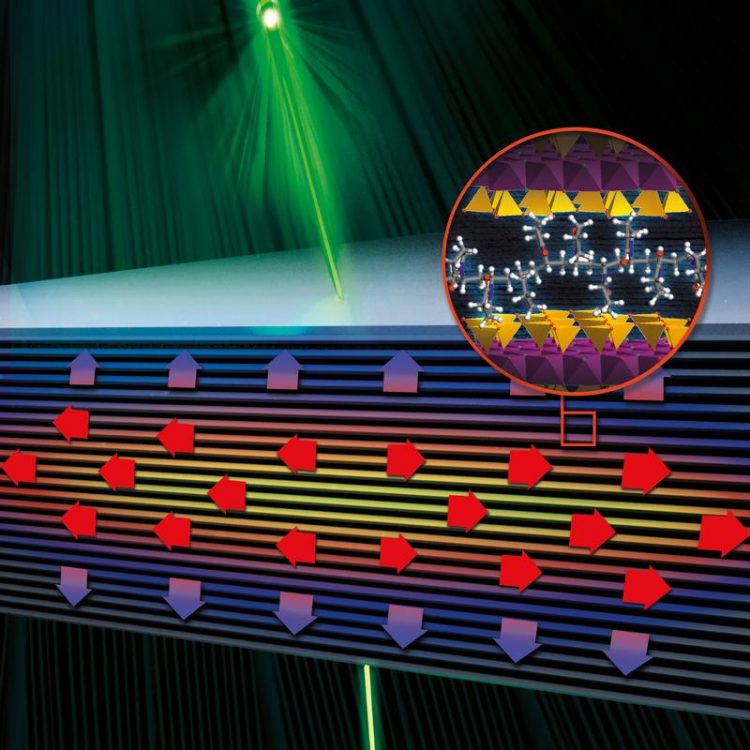Miniature double glazing: Material developed which is heat-insulating and heat-conducting at the same time

The newly developed material conducts heat well along the layers, while at the same time providing thermal insulation vertically. © MPI-P, Lizenz CC-BY-SA
Thermal insulation and thermal conduction play a crucial role in our everyday lives – from computer processors, where it is important to dissipate heat as quickly as possible, to houses, where good insulation is essential for energy costs.
Often extremely light, porous materials such as polystyrene are used for insulation, while heavy materials such as metals are used for heat dissipation.
A newly developed material, which scientists at the MPI-P have jointly developed and characterized with the University of Bayreuth, can now combine both properties.
The material consists of alternating layers of wafer-thin glass plates between which individual polymer chains are inserted. “In principle, our material produced in this way corresponds to the principle of double glazing,” says Markus Retsch, Professor at the University of Bayreuth. “It only shows the difference that we not only have two layers, but hundreds”.
Good thermal insulation is observed perpendicular to the layers. In microscopic terms, heat is a movement or oscillation of individual molecules in the material that is transferred to neighbouring molecules.
By building up many layers on top of each other, this transfer is reduced: Each new boundary layer blocks part of the heat transfer. In contrast, the heat within a layer can be conducted well – there are no interfaces that would block the heat flow. Overall, the heat transfer within a layer is 40 times higher than perpendicular to it.
The thermal conductivity along the layers is comparable to the thermal conductivity of thermal paste, which is used, among other things, to apply heat sinks to computer processors. For electrically insulating materials based on polymer/glass, this value is exceptionally high – it exceeds that of commercially available plastics by a factor of six.
For the material to function efficiently and also be transparent, the layers had to be produced with very high precision – any inhomogeneity would disturb the transparency similar to a scratch in a piece of Plexiglas. Each layer is only one millionth of a millimeter high – i.e. one nanometer.
In order to investigate the homogeneity of the layer sequence, the material was characterized in the group of Josef Breu, Professor of Inorganic Chemistry at the University of Bayreuth.
“We use X-rays to illuminate the material,” says Breu. “By superimposing these rays, which are reflected by the individual layers, we were able to show that the layers could be produced very precisely.”
Prof. Fytas, member of Prof. H.-J. Butt's department, was able to give an answer to the question why this layer-like structure has such extraordinarily different properties along or perpendicular to the individual glass plates.
Using a special laser-based measurement, his group was able to characterize the propagation of sound waves, which is like heat also related to the movement of the material’s molecules.
“This structured yet transparent material is excellent for understanding how sound propagates in different directions,” says Fytas. The different sound velocities allow direct conclusions to be drawn about the direction-dependent mechanical properties, which are not accessible with any other method.
In their further work, the researchers hope to gain a better understanding of how sound and heat propagation can be influenced by the structure of the glass plate and the polymer composition. The researchers see a possible application in the field of high-performance light-emitting diodes, in which the glass-polymer layer serves on the one hand as a transparent encapsulation and on the other hand can dissipate the released heat laterally.
The scientists have now published their results in the renowned journal “Angewandte Chemie – International Edition”.
Prof. Dr. Georg Fytas
MPI für Polymerforschung
Ackermannweg 10
55128 Mainz
Telefon:+49 6131 379-718
E-Mail: fytas@mpip-mainz.mpg.de
Prof. Dr. Josef Breu
Anorganische Chemie I
Universität Bayreuth
Universitätsstrasse 30
95440 Bayreuth
Telefon: +49 (0)921 / 55-3520
E-Mail: josef.breu@uni-bayreuth.de
Prof. Dr. Markus Retsch
Physikalische Chemie I
Universität Bayreuth
Universitätsstrasse 30
95440 Bayreuth
Telefon: +49 (0)921 / 55-3920
E-Mail: markus.retsch@uni-bayreuth.de
Wang, Z.; Rolle, K.; Schilling, T.; Hummel, P.; Philipp, A.; Kopera, B. A. F.; Lechner, A. M.; Retsch, M.; Breu, J.; Fytas, G.: Tunable Thermoelastic Anisotropy in Hybrid Bragg Stacks with Extreme Polymer Confinement. Angewandte Chemie, International Edition in English (2019); https://onlinelibrary.wiley.com/doi/full/10.1002/anie.201911546
Media Contact
More Information:
http://www.mpip-mainz.mpg.deAll latest news from the category: Materials Sciences
Materials management deals with the research, development, manufacturing and processing of raw and industrial materials. Key aspects here are biological and medical issues, which play an increasingly important role in this field.
innovations-report offers in-depth articles related to the development and application of materials and the structure and properties of new materials.
Newest articles

A ‘language’ for ML models to predict nanopore properties
A large number of 2D materials like graphene can have nanopores – small holes formed by missing atoms through which foreign substances can pass. The properties of these nanopores dictate many…

Clinically validated, wearable ultrasound patch
… for continuous blood pressure monitoring. A team of researchers at the University of California San Diego has developed a new and improved wearable ultrasound patch for continuous and noninvasive…

A new puzzle piece for string theory research
Dr. Ksenia Fedosova from the Cluster of Excellence Mathematics Münster, along with an international research team, has proven a conjecture in string theory that physicists had proposed regarding certain equations….



